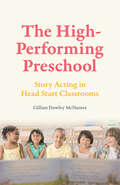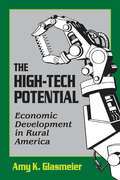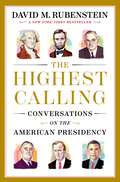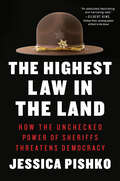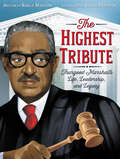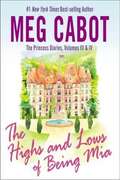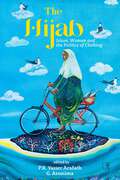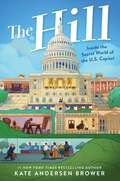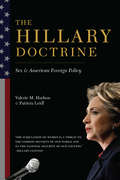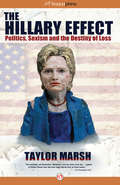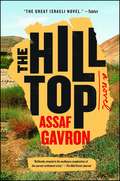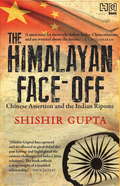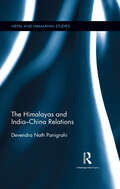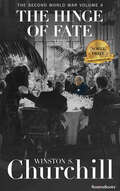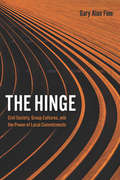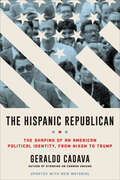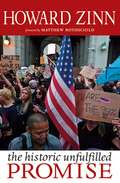- Table View
- List View
The High-Performing Preschool: Story Acting in Head Start Classrooms
by Gillian Dowley McnameeThe High-Performing Preschool takes readers into the lives of three- and four-year-old Head Start students during their first year of school and focuses on the centerpiece of their school day: story acting. In this activity, students act out stories from high-quality children’s literature as well as stories dictated by their peers. Drawing on a unique pair of thinkers--Russian psychologist Lev Vygotsky and renowned American teacher and educational writer Vivian G. Paley--Gillian Dowley McNamee elucidates the ways, and reasons, this activity is so successful. She shows how story acting offers a larger blueprint for curricula that helps ensure all preschools--not just those for society’s well-to-do--are excellent. McNamee outlines how story acting cultivates children’s oral and written language skills. She shows how it creates a crucial opportunity for teachers to guide children inside the interior logic and premises of an idea, and how it fosters the creation of a literary community. Starting with Vygotsky and Paley, McNamee paints a detailed portrait of high-quality preschool teaching, showing how educators can deliver on the promise of Head Start and provide a setting for all young children to become articulate, thoughtful, and literate learners.
The High-Tech Potential
by Amy K. GlasmeierRural America is at a crossroads in its economic development. Like regions of other First World nations, the traditional economic base of rural communities in the United States is rapidly deteriorating. Natural resources, including agriculture, show little prospect for generating future job growth, and manufacturing has become a new source of instability. Faced with these changes and an increasing vulnerability to international economic events, rural communities have begun to seek high-technology industries and advanced services as candidates for job growth and economic stability. What is the potential for high-tech growth outside the largest cities? What is the role of high-tech industry in the economic development of non-metropolitan America? This book provides a hard-nosed look at the high-tech potential in rural economic development. Some of the questions Glasmeier addresses include: Are rural areas attractive to high tech? Will high tech follow earlier patterns and filter down the lowest-paid jobs to rural areas? Will rural communities be bypassed completely for even lower-wage Third World locations? Glasmeier answers in a sober analysis that separates fact from myth. Empirical data reveals the kinds of high-tech jobs that locate in rural areas, and the kinds of rural areas that attract high-tech jobs. This analysis leads to a highly critical evaluation of state and local economic development policy and recommendations for its improvement. This book is a must for policymakers, practitioners, scholars, and an informed public interested in the promise of high tech and the future of US economic development.
The Highest Calling: Conversations on the American Presidency
by David M. RubensteinA NEW YORK TIMES BESTSELLER From the New York Times bestselling author of The American Story and How to Lead and host of PBS&’s History with David Rubenstein—David Rubenstein interviews living American presidents and top historians and journalists who reflect on the US presidency, including Joe Biden, Barack Obama, George W. Bush, Maggie Haberman, Ron Chernow, and more.For years, bestselling author David M. Rubenstein has distilled the contours of American democracy through conversations with noted leaders and historians. In The Highest Calling, he offers an enlightening overview of arguably the single most important position in the world: the American presidency. Blending history and anecdote, Rubenstein chronicles the journeys of the presidents who have defined America as it exists now, what they envision for its future, and their legacy on the world stage. Drawing from his own experience in the Carter administration, he engages in dialogues with our nation&’s presidents and the historians who study them. Get exclusive access to fresh perspectives, including: -Original interviews with most of the living US presidents -Interviews with noted presidential historians like Annette Gordon-Reed, Ron Chernow, Candice Millard, and more Through &“chatty, insightful, and enlightening&” (The Wall Street Journal) analysis, Rubenstein captures our country&’s most prominent leaders, the political genius and frays of the presidential role, and the wisdom that emerges from it.
The Highest Glass Ceiling: Women's Quest for the American Presidency
by Ellen FitzpatrickBest-selling historian Ellen Fitzpatrick tells the story of three remarkable women who set their sights on the Presidency. The arduous, dramatic quests of Victoria Woodhull (1872), Margaret Chase Smith (1964), and Shirley Chisholm (1972) illuminate today's political landscape, shedding light on Hillary Clinton's 2016 campaign for the Oval Office.
The Highest Law in the Land: How the Unchecked Power of Sheriffs Threatens Democracy
by Jessica PishkoShortlisted for Columbia Journalism School&’s J. Anthony Lukas PrizeA Publishers Lunch NonFiction Buzz Book| Named Most Anticipated by Los Angeles Times A leading authority on sheriffs investigates the impunity with which they police their communities, alongside the troubling role they play in American life, law enforcement, and, increasingly, national politics. The figure of the American sheriff has loomed large in popular imagination, though given the outsize jurisdiction sheriffs have over people&’s lives, the office of sheriffs remains a gravely under-examined institution. Locally elected, largely unaccountable, and difficult to remove, the country&’s over three thousand sheriffs, mostly white men, wield immense power—making arrests, running county jails, enforcing evictions and immigration laws—with a quarter of all U.S. law enforcement officers reporting to them. In recent years there&’s been a revival of &“constitutional sheriffs,&” who assert that their authority supersedes that of legislatures, courts, and even the president. They&’ve protested federal mask and vaccine mandates and gun regulations, railed against police reforms, and, ultimately, declared themselves election police, with many endorsing the &“Big Lie&” of a stolen presidential election. They are embraced by far-right militia groups, white nationalists, the Claremont Institute, and former president Donald Trump, who sees them as allies in mass deportation and border policing. How did a group of law enforcement officers decide that they were &“above the law?&” What are the stakes for local and national politics, and for America as a multi-racial democracy? Blending investigative reporting, historical research, and political analysis, author Jessica Pishko takes us to the roots of why sheriffs have become a flashpoint in the current politics of toxic masculinity, guns, white supremacy, and rural resentment, and uncovers how sheriffs have effectively evaded accountability since the nation&’s founding. A must-read for fans of Michelle Alexander, Gilbert King, Elizabeth Hinton, and Kathleen Belew.
The Highest Tribute: Thurgood Marshall's Life, Leadership, and Legacy
by Kekla MagoonA brilliant picture book biography about Thurgood Marshall, who fought for equality during the Civil Rights Movement and served as the first Black justice on the Supreme Court, from Coretta Scott King Honor winners Kekla Magoon and Laura Freeman.Growing up in Baltimore, Thurgood Marshall could see that things weren’t fair. The laws said that Black and white people couldn’t use the same schools, parks, or water fountains.When Thurgood had to read the Constitution as punishment for a prank at school, his eyes were opened. It was clear to him that Jim Crow laws were wrong, and he was willing to do whatever it took to change them.His determination to make sure all Americans were treated equally led him to law school and then the NAACP, where he argued cases like Brown v. Board of Education in front of the Supreme Court. But to become a Justice on the highest court in the land, Thurgood had to make space for himself every step of the way.Readers will be inspired by Kekla Magoon’s concise text and Laura Freeman’s luminous illustrations, which bring Thurgood Marshall’s incredible legacy and achievements to life.* An SLJ Best Book of the Year * A Bank Street Best Book of the Year * A Jane Addams Children's Book Award Finalist * A Texas Topaz Nonfiction Selection * Wisconsin State Reading Association’s 2022 Picture This Recommendation List * Indiana Authors Award Shortlist *
The Highs and Lows of Being Mia: The Princess Diaries, Volumes III & IV
by Meg CabotThis two-in-one volume contains Cabot's #1 "New York Times" bestselling books that continue the story of Princess Mia of Genovia: Volume 3: "Princess in Love" and Volume 4: "Princess in Waiting."
The Highway of Despair
by Robyn MarascoG. W. F. Hegel's "highway of despair," introduced in his Phenomenology of Spirit, refers to the tortured path traveled by "natural consciousness" on its way to freedom. Despair is the passionate residue of Hegelian critique. Through an eclectic cast of thinkers, Robyn Marasco considers the dynamism of despair as a critical passion, reckoning with the forms of historical life forged along Hegel's highway. Despair, for Marasco, also indicates fugitive opportunities for freedom and preserves the principle of hope against all hope. The Highway of Despair follows Theodor Adorno, Georges Bataille, and Frantz Fanon as they each read, resist, and reconfigure a strand of thought in Hegel's Phenomenology of Spirit. Confronting the twentieth-century collapse of a certain revolutionary dialectic, these thinkers struggled to revalue critical philosophy and recast Left Hegelianism within the contexts of genocidal racism, world war, and colonial domination. Each intellectual also re-centered the role of passion in critique. Arguing against more recent trends in critical theory that promise an escape from despair, Marasco shows how passion frustrates the resolutions of reason and faith. Embracing the extremism of what Marx, in the spirit of Hegel, called the "ruthless critique of everything existing," she affirms the contemporary purchase of radical critical theory, resulting in a militant and passionate approach to political thought.
The Highway of Despair: Critical Theory After Hegel (New Directions in Critical Theory #41)
by Robyn MarascoHegel's "highway of despair," introduced in his Phenomenology of Spirit, is the tortured path traveled by "natural consciousness" on its way to freedom. Despair, the passionate residue of Hegelian critique, also indicates fugitive opportunities for freedom and preserves the principle of hope against all hope. Analyzing the works of an eclectic cast of thinkers, Robyn Marasco considers the dynamism of despair as a critical passion, reckoning with the forms of historical life forged along Hegel's highway. The Highway of Despair follows Theodor Adorno, Georges Bataille, and Frantz Fanon as they each read, resist, and reconfigure a strand of thought in Hegel's Phenomenology of Spirit. Confronting the twentieth-century collapse of a certain revolutionary dialectic, these thinkers struggle to revalue critical philosophy and recast Left Hegelianism within the contexts of genocidal racism, world war, and colonial domination. Each thinker also re-centers the role of passion in critique. Arguing against more recent trends in critical theory that promise an escape from despair, Marasco shows how passion frustrates the resolutions of reason and faith. Embracing the extremism of what Marx, in the spirit of Hegel, called the "ruthless critique of everything existing," she affirms the contemporary purchase of radical critical theory, resulting in a passionate approach to political thought.
The Hijab: Islam, Women and the Politics of Clothing
by PK Yasser Arafath G ArunimaHistorically, in India, we have instances of both unveiling and veiling that have been initiated by Indian Muslim women. The early 20th century saw many Muslim women joining the national movement, giving up veiling, feeling this was the only way for them to change their own, and the country's, future. Almost a hundred years later, the hijab continues to be a bone of contention in India, though in very different ways. On one hand, the rape threats that hijabi/non-hijabi women frequently encounter in the cyber world reflect the extreme desperation of the aggravated Hindutva millennials who are made to believe that unveiling Muslim women is their right while a large segment of Indian Muslim women are increasingly convinced that wearing the hijab is their constitutional prerogative. This collection of essays, primarily from India but also with a couple from Bangladesh and Iran, complicates the relationship between Muslim women and the hijab. Moving away from predictable interpretations that see the hijab merely as an instrument of Muslim women&’s oppression, the essays here, from a variety of perspectives including historical, ethnographic, and political, demonstrate that not only have Muslim women covered/ or uncovered their heads for different reasons, but the head cloth itself has had different forms depending on the region or period of history. The essays track the reasons why clothing, especially women&’s attire, is very often a site of contestation and provide ways to hear and understand the ways in which Muslim girls or women make their own sartorial choices. They also offer ways of interpreting the stakes in banning the hijab in different parts of the world, and the implications of the ban on Muslim women, the wider community and the very idea of citizenship itself.
The Hill to Die On: The Battle for Congress and the Future of Trump's America
by Jake Sherman Anna PalmerThe startling inside story of Donald Trump’s first two years in Washington as viewed from Capitol Hill, where lawmakers on both sides of the aisle jockeyed for advantage as American politics reached a fevered pitch. <P><P>Taking readers into secret strategy calls and closed-door meetings from the House to the White House, Politico Playbook writers Jake Sherman and Anna Palmer trace the gamesmanship and the impulsiveness, the dealmaking and the backstabbing, in a blow-by-blow account of the power struggle that roiled Congress. <P><P>Moving from the fights for advantage between Donald Trump, Nancy Pelosi, and Chuck Schumer; to Mitch McConnell’s merciless, Machiavellian handling of the sexual assault accusations against Supreme Court nominee Brett Kavanaugh; to Paul Ryan’s desperate, failed attempts to keep Mark Meadows from pushing Trump into a government shutdown over immigration, The Hill to Die On bristles with fresh news and tells the story of what really happened in some of the most defining moments our era. <P><P>Like The West Wing for Congress, or Shattered meets This Town, The Hill to Die On tells an unforgettable story of politics and power, where the stakes going forward are nothing less than the future of America and the lives of millions of ordinary Americans. <P><b>A New York Times Bestseller</b>
The Hill: Inside the Secret World of the U.S. Capitol
by Kate Andersen Brower#1 New York Times bestselling author Kate Andersen Brower shares a special look inside America’s Capitol and highlights what the people who work there mean to the future of democracy. Perfect for readers of Brower’s first middle grade book, Exploring the White House!There’s a secret world hidden in the halls of the U.S. Capitol!The first stone was laid by George Washington himself, and the building stands today as one of the most recognizable symbols of the oldest democracy in the world. In this home of America’s legislative branch, senators and representatives fight to pass laws they believe are for the good of the country.But these hallowed halls, which some swear are haunted, also harbor a deep history—both extraordinary and unsettling—and that is an equally important part of America’s story.There is an entire universe tucked away inside the Capitol, and #1 New York Times bestselling author Kate Andersen Brower highlights the historic firsts, the building’s restricted nooks and crannies, and the staffers—from pages to doorkeepers to librarians—who ensure that American democracy stays on track.
The Hillary Doctrine
by Swanee Hunt Valerie M. Hudson Patricia LeidlHillary Rodham Clinton is the first Secretary of State to declare the subjugation of women worldwide a serious threat to U.S. national security. Known as the Hillary Doctrine, her stance was made part of the 2010 Quadrennial Diplomatic and Development Review of U.S. foreign policy, formally committing America to the proposition that the empowerment of women is a stabilizing force for domestic and international peace.Blending history, fieldwork, theory, and policy analysis while incorporating perspectives from officials and activists on the front lines of implementation, this is the first book to thoroughly investigate the Hillary Doctrine in principle and practice. Does the insecurity of women make nations less secure? How has the doctrine changed the foreign policy of the United States and altered its relationship with other countries, such as China and Mexico? With specific studies of Guatemala, Afghanistan, Saudi Arabia, and Yemen, this invaluable policy text closes the gap between rhetoric and reality, confronting head-on what the future of fighting such an entrenched enemy entails. It reports directly on the work being done by U.S. government agencies, including the Office of Global Women's Issues, established by Clinton during her tenure at the State Department, and explores the complexity and pitfalls of attempting to improve the lives of women while safeguarding the national interest.
The Hillary Doctrine: Sex and American Foreign Policy
by Patricia Leidl Valerie HudsonHillary Rodham Clinton was the first Secretary of State to declare the subjugation of women worldwide a serious threat to U.S. national security. Known as the Hillary Doctrine, her stance was the impetus behind the 2010 Quadrennial Diplomatic and Development Review of U.S. foreign policy, formally committing America to the proposition that the empowerment of women is a stabilizing force for domestic and international peace.Blending history, fieldwork, theory, and policy analysis while incorporating perspectives from officials and activists on the front lines of implementation, this book is the first to thoroughly investigate the Hillary Doctrine in principle and practice. Does the insecurity of women make nations less secure? How has the doctrine changed the foreign policy of the United States and altered its relationship with other countries such as China and Saudi Arabia? With studies focusing on Guatemala, Afghanistan, and Yemen, this invaluable policy text closes the gap between rhetoric and reality, confronting head-on what the future of fighting such an entrenched enemy entails. The research reports directly on the work being done by U.S. government agencies, including the Office of Global Women's Issues, established by Clinton during her tenure at the State Department, and explores the complexity and pitfalls of attempting to improve the lives of women while safeguarding the national interest.
The Hillary Effect
by Taylor MarshSpanning nearly two decades of American politics, The Hillary Effect is the provocative and insightful story of the first viable female presidential candidate in history to win a primary and do so in spite of her campaign team's mistakes. It addresses the galvanizing impact that her loss represented for both women and men, in and out of Washington. And it revolves around media coverage that treated her differently as first lady, senator, and then presidential candidate--not only because she was a woman, but because she was Hillary Clinton.Candidly written by veteran political analyst Taylor Marsh, this is the view from a recovering partisan, someone whom the Washington Post called a "die hard Clintonite" in its profile of Hillary in 2008.The Hillary Effect began when Hillary, as first lady, dared to challenge China's treatment of women. A countless number of women have benefited and will benefit from her presidential loss, the most famous of these being Sarah Palin (the Tea Party queen of 2010 and first female on a national Republican presidential ticket), who weaves throughout this story as the anti-Hillary. The Hillary Effect also sees Michele Bachmann as a player, as the first Republican female to win a straw poll, primary, or caucus.The male leads in this stunning tale are Bill Clinton and President Barack Obama (someone who turned out to be very different from candidate Obama), with David Plouffe and Mark Penn making appearances. The story includes a host of media personalities and their outlets, but also new-media and progressive voices, and famous names like Chris Matthews, Keith Olbermann, Sally Quinn, the late Tim Russert, Richard Wolffe, Laura Ingraham, Liz Cheney, Peggy Noonan, Maureen Dowd, Tucker Carlson, Sean Hannity, Rush Limbaugh, and even Bill O'Reilly, who offered Hillary the best interview she would do during the 2008 season.All of this is seen through the economic and political crises of today--health care, women's individual freedoms, Afghanistan, women's rise around the world, the debt-ceiling debate, tax cuts for the wealthy, Occupy Wall Street, and an American public disenchanted with both Republicans and Democrats.
The Hilltop: A Novel
by Assaf GavronMordantly funny and deeply moving, this award-winning novel about life in a West Bank settlement has been hailed as “brilliant” (The New York Times Book Review) and “The Great Israeli Novel [in which] Gavron stakes his claim to be Israel’s Jonathan Franzen” (Tablet).On a rocky hilltop stands Ma’aleh Hermesh C, a fledgling outpost of Jewish settlers in the West Bank. According to government records it doesn’t exist; according to the military it must be defended. On this contested land, Othniel Assis—under the wary gaze of the Palestinians in the neighboring village—lives on his farm with his ever-expanding family. As Othniel cheerfully manipulates government agencies, more settlers arrive, and a hodge-podge of shipping containers and mobile homes takes root. One steadfast resident is Gabi Kupper, a former kibbutz dweller who savors the delicate routines of life on the settlement. When Gabi’s prodigal brother, Roni, arrives penniless on his doorstep with a bizarre plan to sell the “artisanal” olive oil from the Palestinian village to Tel Aviv yuppies, Gabi worries his life won’t stay quiet for long. Then a nosy American journalist stumbles into Ma’aleh Hermesh C, and Gabi’s worst fears are confirmed. The settlement becomes the focus of an international diplomatic scandal, facing its greatest threat yet. This “indispensable novel” (The Wall Street Journal) skewers the complex, often absurd reality of life in Israel. Grappling with one of the most charged geo-political issues of our time, “Gavron’s story gains a foothold in our hearts and minds and stubbornly refuses to leave” (Kirkus Reviews, starred review).
The Himalayan Face-Off
by Shishir GuptaÔEven if bilateral trade between India and China goes beyond $100 billion in the coming years, ChinaÕs posture towards India is adversarial and will perhaps remain so in the future, with Beijing viewing New Delhi through the prism of the Dalai Lama and the Tibetan government-in-exileÉ A rising China, inflexible on boundary dispute resolution and with strong tentacles across South Asia and beyond, could encroach on IndiaÕs strategic space and lead to a potential crisis this decade.Õ In April 2013, Indian troops sighted an advance patrol of the Chinese PeopleÕs Liberation Army (PLA) 19 km deep within Indian territory, a considerable distance from the Line of Actual Control, the de facto border claim line that was drawn up after the 1962 war between the two countries ? a war that still traumatizes the mind of IndiaÕs political and military establishment. Protracted negotiations led to the withdrawal of Chinese troops, but the incursion laid bare the intent of the worldÕs largest standing army. Despite recent advances in the bilateral relationship, highlighted by the nearly $70 billion trade between the two countries, China continues to regard Indian interests as secondary, and India as a regional adversary. In this breakthrough work, seasoned journalist and author of the bestselling Indian Mujahideen Shishir Gupta details the various advances made by Beijing, particularly the PLA, in encircling India and stifling the latterÕs bid to break out as an aspiring superpower. Gupta discusses Indian political, diplomatic and military responses to ChinaÕs assertion in the subcontinent and beyond, and the various course corrections India must undergo in its foreign and defence policies to counter ChinaÕs might and influence on matters of IndiaÕs national security. In describing how India must realize and counter ChinaÕs clout over its friends and enemies if it is to achieve superpower status, Gupta sheds new light on Indo-China relations. The Himalayan Face-Off: Chinese Assertion and the Indian Riposte is an important reminder of the realigned geopolitics of the modern world, where the two most populous nations on the planet are essentially battling each other over their share of the global pie ? sometimes on the worldÕs highest battlegrounds. '
The Himalayas and India-China Relations (Nepal and Himalayan Studies)
by Devendra Nath PanigrahiThis book provides a systematic analysis of China's rise to power. It traces the complex contours of its relation with India, with the Himalayas prominently figuring in the discourse. Drawing on myths, legends, classical literature, archival resources and contemporary political and international affairs, it brings to the fore several critical issues integral to India–China relations. It also studies the two nations in terms of trade across borders, exchange of ideas and confluence of diverse cultures, imperial strategic rivalries in the colonial period, and recent military skirmishes and diplomatic interaction. Lucid and explanatory, this volume will interest scholars and researchers in international relations, history, political science and area studies specially those interested in the geopolitics of India and China.
The Hindu [Mon, 27 Nov 2017]
by Mukund PadmanabhanArticles in this issue: Why don’t you trust PM, Law Minister asks judiciary Tension as Fathima college students climb up cell tower Humanity must unite to fight terrorism, says Modi Five killed, 12 injured in two accidents T.N. police to soon serve summons on mobile phones Election Commission issues notice to Gujarat Archbishop Political sparks fly at sammelana Equal facilities sought for majority, minority communities BJP leader to file defamation case against Minister Master Plan–2031: The road ahead Workers who clean the garbage in people’s minds Faulty EVMs, missing voter names in U.P. civic elections Pak. will be isolated: Jaitley Nepal’s historic polls see 65% turnout Kannada sammelana ends; sparks fly on last day Run machine Modi stresses on balance Padmavati row: shooting halted for 15 minutes ‘Knowledge has half-life’ 26brief3 26brief1 26brief2 Elephant electrocuted ‘Judicial independence among basic features’ Padmavati row: over 300 detained in Chittorgarh Mystery over kidnapping of bank officials deepens State gets the ball rolling on plastic park Candidates race against time to finish CAT Stakeholders hope record will boost ‘yoga tourism’ Old certitudes vanish in Central Gujarat PM lays stress on balance of power ‘Citizens should be eyes, ears of security forces’ IAF banks on Tejas, new fighter to bolster fleet Powerlooms, Patidars and poll play in Surat Pakistan will be isolated: Jaitley Pope in South Asia, but no invite from India A family in Israel prays for terror attack victims M.P. moots death for rape of girls aged 12 and below A memorial for indentured labourers at Kolkata ghat Acid attack: Army jawan held after 8 years Malfunctioning EVMs, missing voter names in Lucknow municipal polls Tripura bank employees’ abduction mystery deepens VHP Dharma Sansad bats for total beef ban Why don’t you trust PM, asks Law Minister Rajnath leaves for Russia, to sign 2 pacts Humanity must unite to fight terror: PM ‘No’ to Islamic banking Parties struggle with lists before due date De-radicalised 86 people in 2 years: ATS OPS calls for truce HAL can push the envelope Padmavati row: Over 300 detained in Chittorgarh ‘Slap higher tax on shady ITR revisions’ J&K; special envoy visits Pulwama Wedded to Mann ki Baat Guha tweets about ‘rude’ airline staff Police got an upgrade post 26/11 Vyapam case: future of 200 students uncertain S Durga to be screened for jury today Common cause Mercury dips in J&K; Animal carnival Kidnapping mystery deepens ‘Make China comply with WTO norms’ Bill on quota in private sector in RS film and television industry comes out in support of Padmavati Ammunition seized in raid on arms dealer’s house Odisha parties seek Mahanadi tribunal Congress seeking refuge in casteism: Rupani People from Amethi come to Gujarat for jobs: Amit Shah Go ahead with son’s wedding without fear: Tej Pratap to Sushil Modi CG-ACCIDENT (BES12) Protests by Islamist group paralyse Pakistan’s cities Nepal sees peaceful voting Govt. wary of firm action? Christians here live in constant fear Explosion in Chinese port city leaves 2 dead Tehran, Nov 26, 2017 (AFP) - Kano, Nigeria, Nov 26, 2017 (AFP) - Beirut, Nov 26, 2017 (AFP) - Smart-balancing China A toolkit to think local Locked out, without a GI tag The trial of the rebel angel Messy fix
The Hinge of Fate (Winston S. Churchill The Second World Wa #4)
by Winston S. ChurchillThe British prime minister recounts battles from Midway to Stalingrad, and how the Allies turned the tide of WWII: &“Superlative.&” —The New York Times The Hinge of Fate is the dramatic account of the Allies&’ changing fortunes. In the first half of the book, Winston Churchill describes the fearful period in which the Germans threaten to overwhelm the Red Army, Rommel dominates the war in the desert, and Singapore falls to the Japanese. In the span of just a few months, the Allies begin to turn the tide, achieving decisive victories at Midway and Guadalcanal, and repulsing the Germans at Stalingrad. As confidence builds, the Allies begin to gain ground against the Axis powers. This is the fourth in the six-volume account of World War II told from the unique viewpoint of the man who led his nation in the fight against tyranny. The series is enriched with extensive primary sources, as we are presented with not only Churchill&’s retrospective analysis of the war, but also memos, letters, orders, speeches, and telegrams, day-by-day accounts of reactions as the drama intensifies. Throughout these volumes, we listen as strategies and counterstrategies unfold in response to Hitler&’s conquest of Europe, planned invasion of England, and assault on Russia, in a mesmerizing account of the crucial decisions made as the fate of the world hangs in the balance. &“No memoirs by generals or politicians . . . are in the same class.&” —The New York Times
The Hinge of Fate: 1950 (Winston S. Churchill The Second World Wa #4)
by Winston S. ChurchillThe British prime minister recounts battles from Midway to Stalingrad, and how the Allies turned the tide of WWII: &“Superlative.&” —The New York Times The Hinge of Fate is the dramatic account of the Allies&’ changing fortunes. In the first half of the book, Winston Churchill describes the fearful period in which the Germans threaten to overwhelm the Red Army, Rommel dominates the war in the desert, and Singapore falls to the Japanese. In the span of just a few months, the Allies begin to turn the tide, achieving decisive victories at Midway and Guadalcanal, and repulsing the Germans at Stalingrad. As confidence builds, the Allies begin to gain ground against the Axis powers. This is the fourth in the six-volume account of World War II told from the unique viewpoint of the man who led his nation in the fight against tyranny. The series is enriched with extensive primary sources, as we are presented with not only Churchill&’s retrospective analysis of the war, but also memos, letters, orders, speeches, and telegrams, day-by-day accounts of reactions as the drama intensifies. Throughout these volumes, we listen as strategies and counterstrategies unfold in response to Hitler&’s conquest of Europe, planned invasion of England, and assault on Russia, in a mesmerizing account of the crucial decisions made as the fate of the world hangs in the balance. &“No memoirs by generals or politicians . . . are in the same class.&” —The New York Times
The Hinge: Civil Society, Group Cultures, and the Power of Local Commitments
by Gary Alan FineMost of the time, we believe our daily lives to be governed by structures determined from above: laws that dictate our behavior, companies that pay our wages, even climate patterns that determine what we eat or where we live. In contrast, social organization is often a feature of local organization. While those forces may seem beyond individual grasp, we often come together in small communities to change circumstances that would otherwise flatten us. Challenging traditional sociological models of powerful forces, in The Hinge, Gary Alan Fine emphasizes and describes those meso-level collectives, the organizations that bridge our individual interests and the larger structures that shape our lives. Focusing on “tiny publics,” he describes meso-level social collectives as “hinges”: groups that come together to pursue a shared social goal, bridging the individual and the broader society. Understanding these hinges, Fine argues, is crucial to explaining how societies function, creating links between the micro- and macro-orders of society. He draws on historical cases and fieldwork to illustrate how these hinges work and how to describe them. In The Hinge, Fine has given us powerful new theoretical tools for understanding an essential part of our social worlds.
The Hispanic Republican: The Shaping of an American Political Identity, from Nixon to Trump
by Geraldo L. CadavaAn illuminating and thought-provoking history of the growth of Hispanic American Republican voters in the past half century and their surprising impact on US politics, updated with new material reflecting on the 2020 electionIn the lead-up to every election cycle, pundits predict that Latino Americans will overwhelmingly vote in favor of the Democratic candidate. And it’s true—Latino voters do tilt Democratic. Hillary Clinton won the Latino vote in a “landslide,” Barack Obama “crushed” Mitt Romney among Latino voters in his reelection, and, four years earlier, the Democratic ticket beat the McCain-Palin ticket by a margin of more than two to one. But those numbers belie a more complicated picture. Because of decades of investment and political courtship, as well as a nuanced and varied cultural identity, the Republican party has had a much longer and stronger bond with Hispanics. How is this possible for a party so associated with draconian immigration and racial policies?In The Hispanic Republican, historian and political commentator Geraldo Cadava illuminates the history of the millions of Hispanic Republicans who, since the 1960s, have had a significant impact on national politics. Intertwining the little understood history of Hispanic Americans with a cultural study of how post–World War II Republican politicians actively courted the Hispanic vote during the Cold War (especially Cuban émigrés) and during periods of major strife in Central America (especially during Iran-Contra), Cadava offers insight into the complicated dynamic between Latino liberalism and conservatism, which, when studied together, shine a crucial light on a rapidly changing demographic that will impact American elections for years to come.
The Historians: A Novel
by Cecilia EkbäckThe Secret History meets Fatherland <P><P> Before the war they were the best of friends. Five brilliant young historians debated origins, ideas and the place of history in modern times under the guidance of the charismatic Professor Lindahl. When war broke out the five disbanded, ending up on different sides. Now one of them has been found tortured and killed . . . It is 1943 and Sweden’s neutrality in the war is under pressure. Laura Dahlgren, a bright young historian who is the right hand of the chief negotiator with Germany, is privy to ongoing discussions about the transport of German soldiers to occupied Norway and German access to Swedish iron ore. When her former best friend and fellow classmate, Britta, is discovered tortured and murdered, Laura is determined to find her killer. In the Swedish government, the secretary to the unpopular minister of foreign affairs, Jens Regnell, is sent Britta’s PhD thesis on Scandinavian supremacy without understanding why, just as he is becoming increasingly worried that his boss is secretly negotiating with the Reich without informing the government. In Lapland, near the iron mine, Sami are mysteriously disappearing. Taneli, a young Sami boy, decides to investigate after his sister suddenly goes missing. Together these three people will uncover a conspiracy that could topple their government and destroy their country’s identity—a conspiracy that others are desperate to contain at any cost necessary.
The Historic Unfulfilled Promise
by Howard Zinn Mathew RothschildHoward Zinn's life and work are the stuff of legend. His People's History of the United States has sold over two million copies and has altered how we see and teach history. A hero in word and deed, Zinn's views on freedom, fairness, history, democracy, and our own human potential are educational and transformative. In few places is the genius of his voice more crystallized and accessible than in the dozens of articles he penned for The Progressive magazine from 1980 to 2009, offered together here in book form for the first time. Whether critiquing the Barack Obama White House, the sorry state of US government and politics, the tragic futility of US military actions in Afghanistan and Iraq, or the plight of working people in an economy rigged to benefit the rich and powerful, Zinn's historical clarity, unflappable optimism, and unshakable questions reverberate throughout The Historic Unfulfilled Promise: "Have our political leaders gone mad?" "What kind of country do we want to live in?" "What is national security?" "Do we have a right to occupy a country when the people of that country obviously do not want us there?" "Is not war itself terrorism?" "Should we not begin to consider all children, everywhere, as our own?" "Has the will of the people been followed?" The Historic Unfulfilled Promise is a genuine work of conscience, rich in ideas, charged with energy; an invaluable introduction for the uninitiated and a must-have for Zinn's fans.
